How Much Do Hybrids Currently Depreciate?

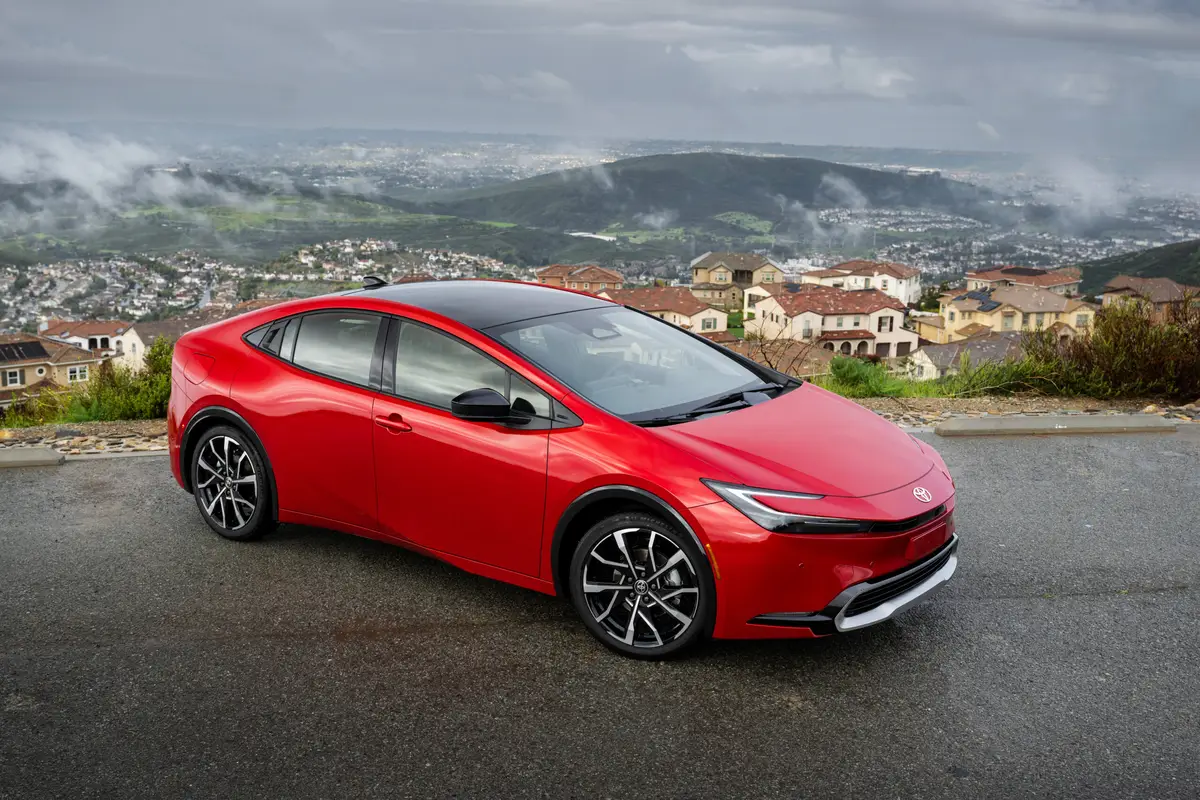
With many buyers looking to save money on fuel but uncertain about going fully electric, hybrids are hot right now, especially with uncertainty over tariffs that could affect car and fuel prices in the near future. Naturally, affordability-minded shoppers may want to shop used to score a good deal — or perhaps pick up a ride that keeps a higher-than-average resale value over time. Letting someone else take the depreciation hit has always been a solid strategy for getting the car you want at a lower price, so how much do hybrids depreciate?
Related: Which Used Hybrids Are Most Available?
Finding a used hybrid has never been easier, as automakers increasingly turn to hybrid powertrains to meet customers’ desires for more fuel-efficient cars as well as tightening fuel economy and emissions standards. Cars.com had over 285,000 new hybrids and plug-in hybrids for sale in its inventory in February 2025 compared to just under 73,000 in February 2019; that’s a growth rate of just over 291% in six years. You can save big bucks by turning to used hybrids, too. The average list price of a new hybrid (plug-in and non-plug-in) was roughly $48,200 in February 2025, while the average used list price was over $16,000 less.
To find out just how much and how quickly hybrids depreciate, we took a look at new and used list prices on Cars.com listings split out by model year. We also took a look at PHEVs, which cost a bit more when new and compared with their non-plug-in cousins, separately to see if there’s any difference. Additionally, we looked at several popular models to see how some favorites have fared over the years.
Some notes on methodology: Unless specified otherwise, we’ll refer to “hybrid” to include only non-plug-in variety when discussing these stats and specify PHEV when we’re talking about plug-ins. We gathered statistics going back up to 12 years when available, as the average age of vehicles on the road was 12.6 years in 2024, according to the U.S. Bureau of Transportation Statistics. All statistics were pulled from Cars.com listing data as of February 2025.
What Is Hybrid Depreciation Like?
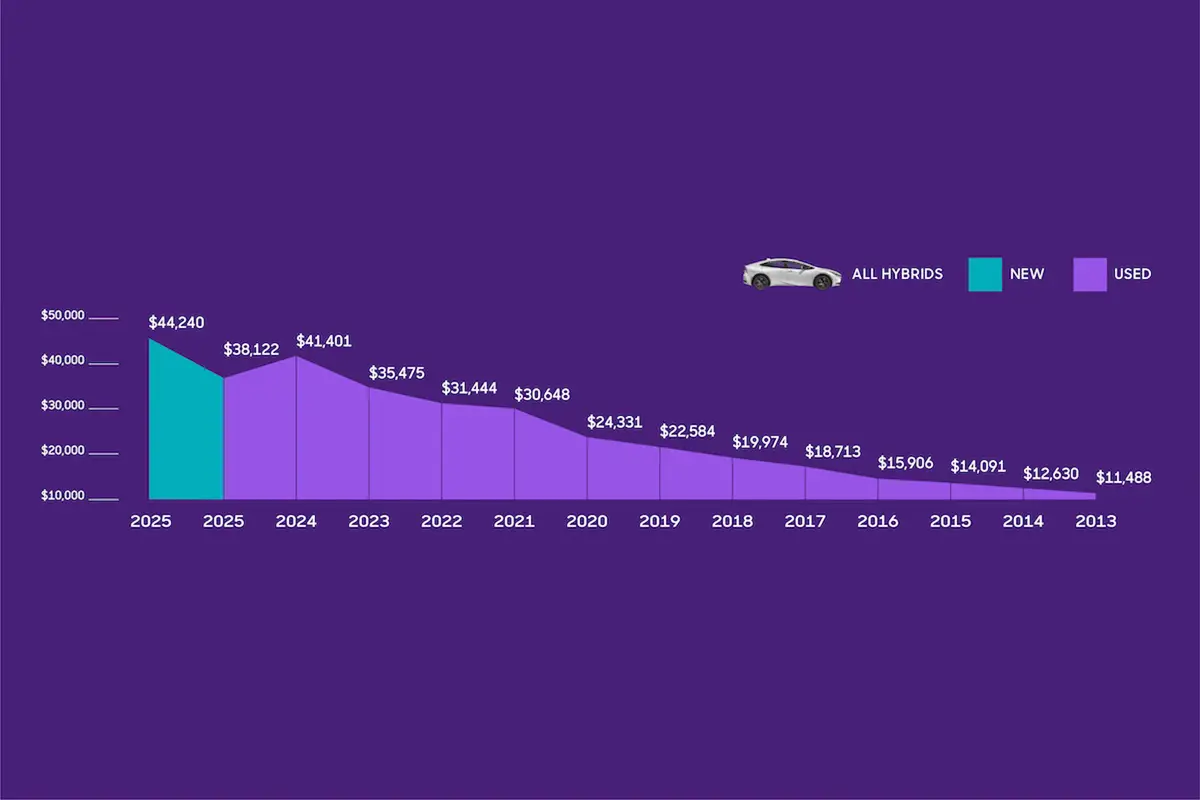
If you don’t have anywhere to plug in a PHEV, a non-plug-in hybrid is often the more practical choice. They cost less when new on average — $44,240 compared to $69,124 for PHEVs — and are far more common, with many more budget-oriented options available, including the Toyota RAV4 Hybrid and Honda Accord hybrid. While it’s still a bit early to find many used model-year 2025 hybrids on the lots, simply going from a new 2025 hybrid to a used one can save you an average of $6,118. More widely available used 2024 hybrids are slightly more expensive, but still save you an average of $2,839 over their new 2025 counterparts.
On average, hybrids hold their value better than PHEVs over time, as well. Only model-year 2013 and 2017 PHEVs pack a lower average price than non-plug-in counterparts. Even then, a used hybrid can still be a great deal. Many consider three-year-old and newer vehicles to be the most desirable, and while those are in short supply across the board this year, used hybrids still pack substantial savings on average compared to their new counterparts. A used 2024 model is about 94% of the price of a new 2025 model, while a 2023 drops to 80% of the new-car average, and a 2022 is just 71%. Aim for a 2020 hybrid, and it’s an average of 45% less than a new 2025 hybrid; go back 10 years, and you’re looking at an average price that’s just 32% of the new-car price. By the time you’re looking at 2013 hybrids, the average list price is just a little over a quarter of the average price of a new 2025 model.
In that time, however, we’ve seen more and more popular models introducing, bringing back or making standard a hybrid powertrain option, so it’s no surprise to see late-model hybrids keep their value this well. Take, for example, the popular Ford Maverick compact pickup truck, whose hybrid version has been keeping more of its value compared to the average hybrid since its release for model-year 2022. A three-year-old, first-year Maverick hybrid keeps 77% of its value compared to the average hybrid’s 71%. To see how that would play out over a longer time span, let’s take a look at a few popular models with longer histories.
Toyota Prius
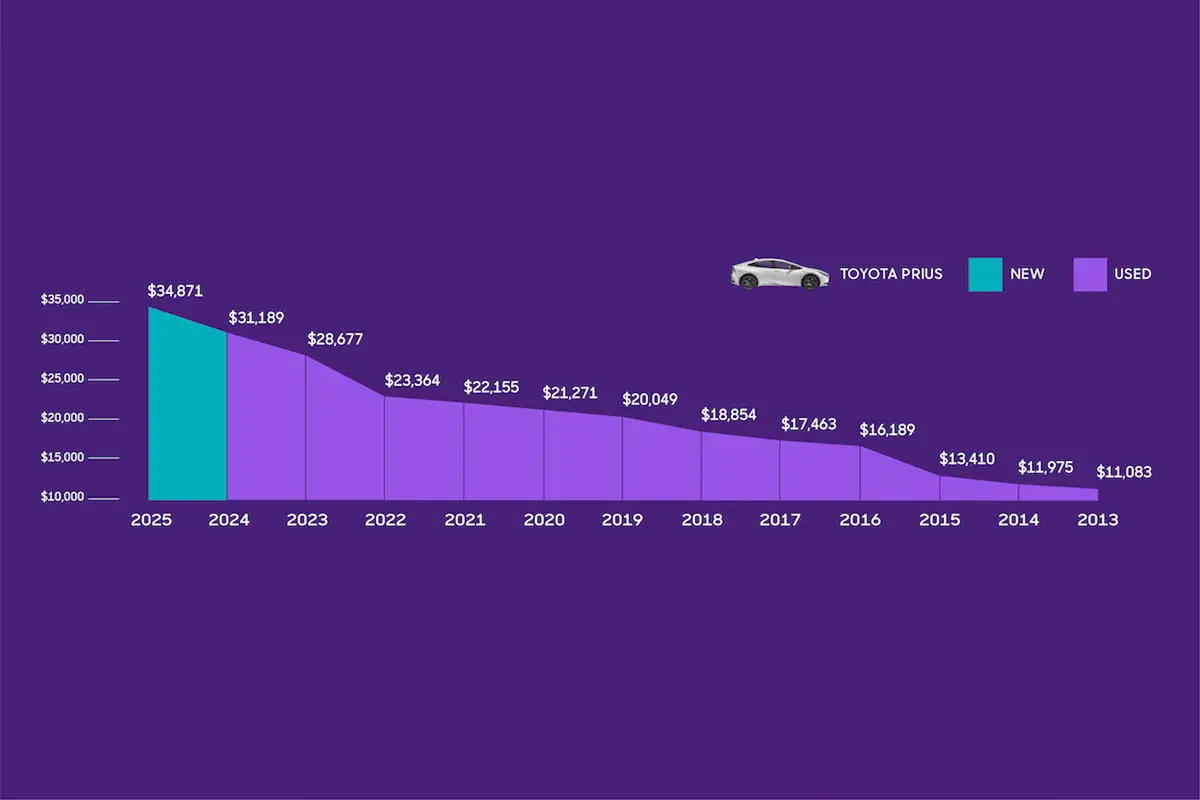
If any vehicle is synonymous with the word “hybrid,” it would be the Toyota Prius, the model that really kick-started the widespread acceptance of hybrid powertrains as an option for efficiency-minded motorists. The Prius in general is one of the most widely available hybrids on the market thanks to the model’s long lifetime, so there’s a good chance you have some wiggle room to negotiate a lower price.
The latest Prius generation that kicked off with the 2023 model year is much more fun to drive and modern-looking than its predecessors, which could explain why there’s a sharp drop-off in average prices for models before then. On average, a used 2024 Prius is about 12% less than a new 2025 model, and a used 2023 model is 18% less. Meanwhile, you’ll pay an average of 33% less than that average new-Prius price for a three-year-old model. At $23,364, the average 2022 Prius is a really good deal for folks who just want a reasonably priced, frugal car and don’t particularly care about the better driving dynamics of the current gen.
Older Prius models tend to hold their value better than the average hybrid car, too, likely thanks to Toyota’s reputation for reliability and its long history of producing the model. As such, 2020 models cost 61% of a new 2025 model, while 10-year-old Prius models are 38% of the new car’s average cost.
Honda Accord Hybrid
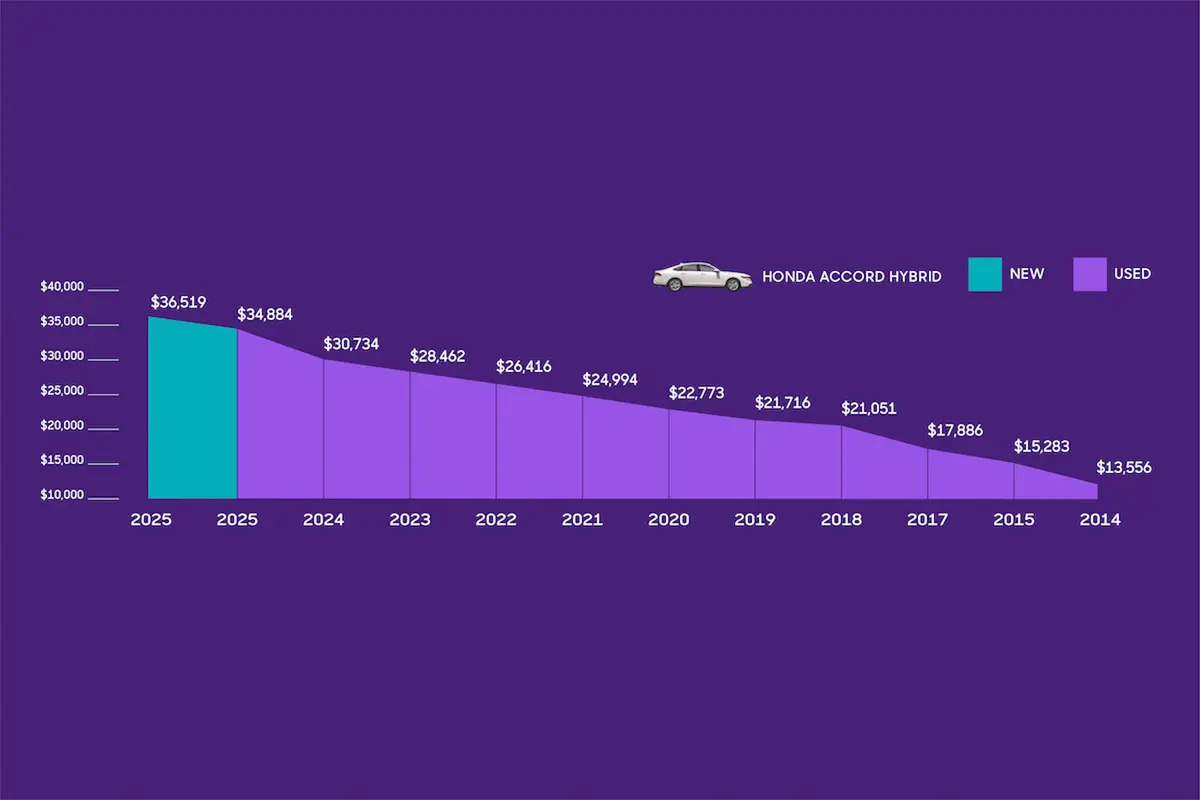
Not everyone wants to shout from the rooftops that they bought a greener ride. As hybrid powertrains gained acceptance, they started to make their way into regular cars that mostly looked the same as their non-hybrid counterparts.
For Accord hybrid shoppers, the combination of a historically reliable nameplate plus a frugal powertrain means that it keeps far more of its value compared to the average hybrid. The average model-year 2014 Accord hybrid is still worth 37% of a new 2025 Accord hybrid’s average list price compared to the average 2014 hybrid, which sells for around 20% of the price of a new 2025 model.
This doesn’t mean older Accord hybrids won’t still be a decent deal. Merely taking one of the used 2025 models off the lot compared to a new one is enough to save you $1,635 on average. The current-generation Accord hybrid debuted for 2023, and opting for a 2023 model will save you an average of 22% off the price of a new 2025 model. The final year of the last-gen Accord hybrid — a 2022 — knocks an extra 6% off.
Toyota RAV4 Hybrid
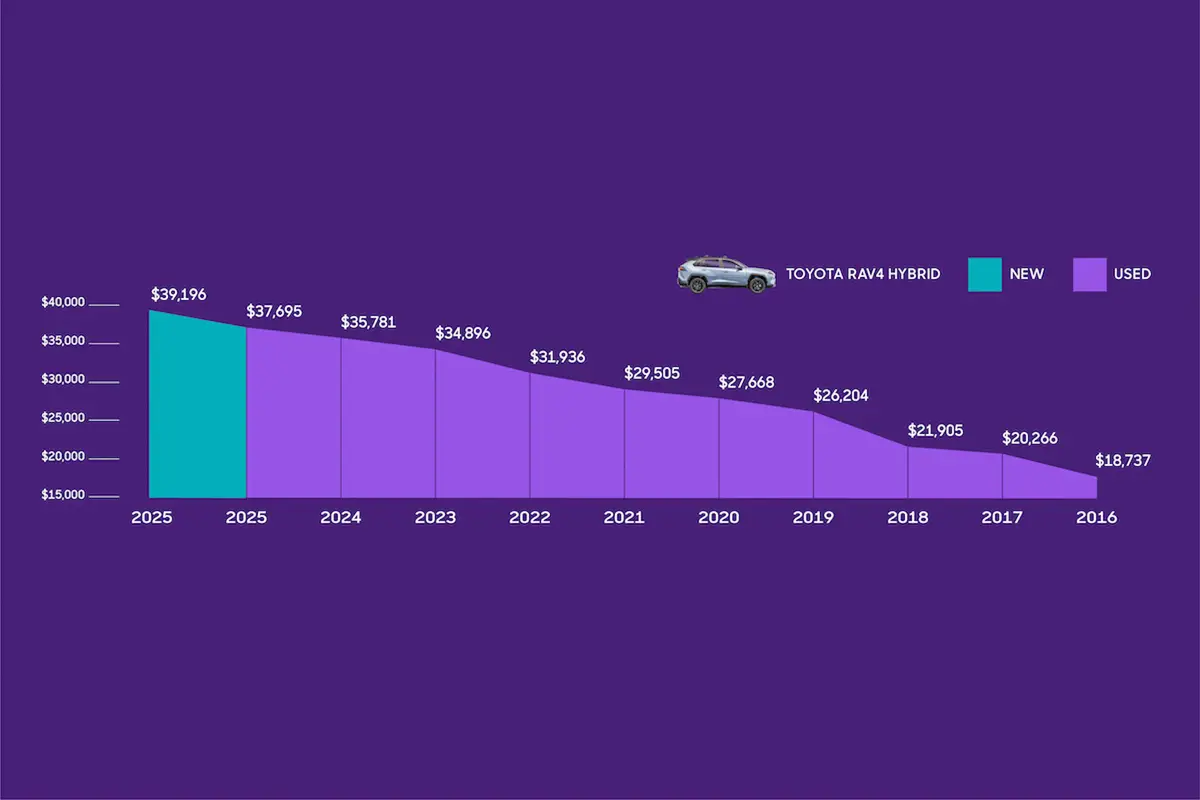
Toyota’s ultra-popular RAV4 SUV has only had a hybrid variant since the 2016 model year, but of the models we took a closer look at for this article, it’s the one that holds its value the best. The average debut-year 2016 RAV4 Hybrid is worth 48% of the price of a new 2025 model, and you have to go all the way back to the 2021 model year for used RAV4 Hybrid prices to dip to 75% of the new model’s price.
Going used will still save you some cash and leave you with a vehicle that has excellent resale values, though. A barely or technically used 2025 RAV4 Hybrid costs $1,501 less on average than one listed as new, and opting for a three-year-old RAV4 Hybrid can knock an average of $7,260 off the new price. The current-generation RAV4 Hybrid has been in production since model-year 2019, though, where the average price is 67% of what a new RAV4 Hybrid costs — a full $12,992 less.
Hyundai Sonata Hybrid
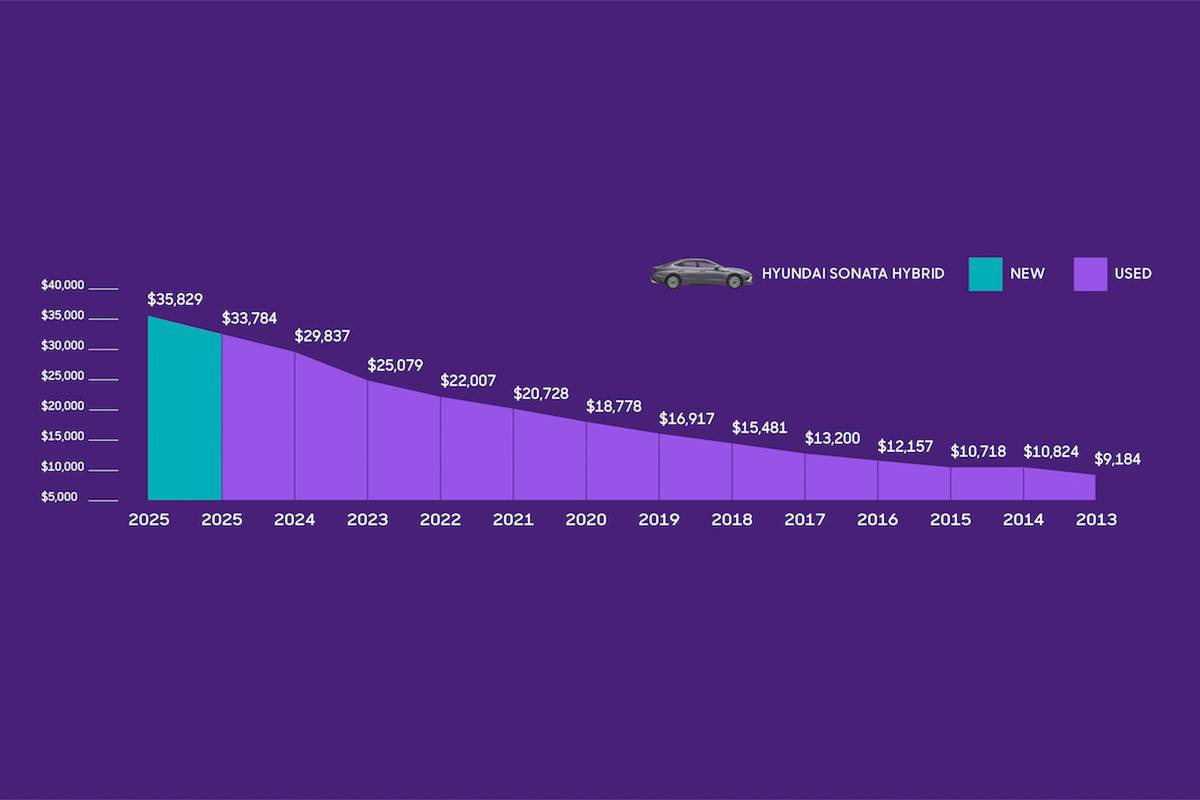
If you’re more concerned about paying less upfront than your car’s residual value, consider the Hyundai Sonata Hybrid. The Sonata Hybrid depreciates even faster than the average hybrid, with three-year-old 2022 examples costing an average of just 61% of the price of a new 2025 model. The current-gen Sonata Hybrid was introduced for 2020, and those first-year examples are going for an average price of $18,778 — nearly half of what a new 2025 model costs.
Hyundai may not be as synonymous with hybrids as Toyota, but it’s been quietly expanding its electrified offerings for some time now. Unfortunately for Hyundai, a spate of TikTok-fueled thefts and a historically less reliable reputation mean that the brand wasn’t always the critics’ darling it is today. However, the Sonata Hybrid was an upgrade over the base Sonata and wasn’t as easy to steal as its base-model brethren. So, a less in-demand used brand could mean big savings for you. Go back 12 years to the 2013 model, and average Sonata Hybrid prices dip below $10,000.
What Is Plug-In Hybrid Depreciation Like?
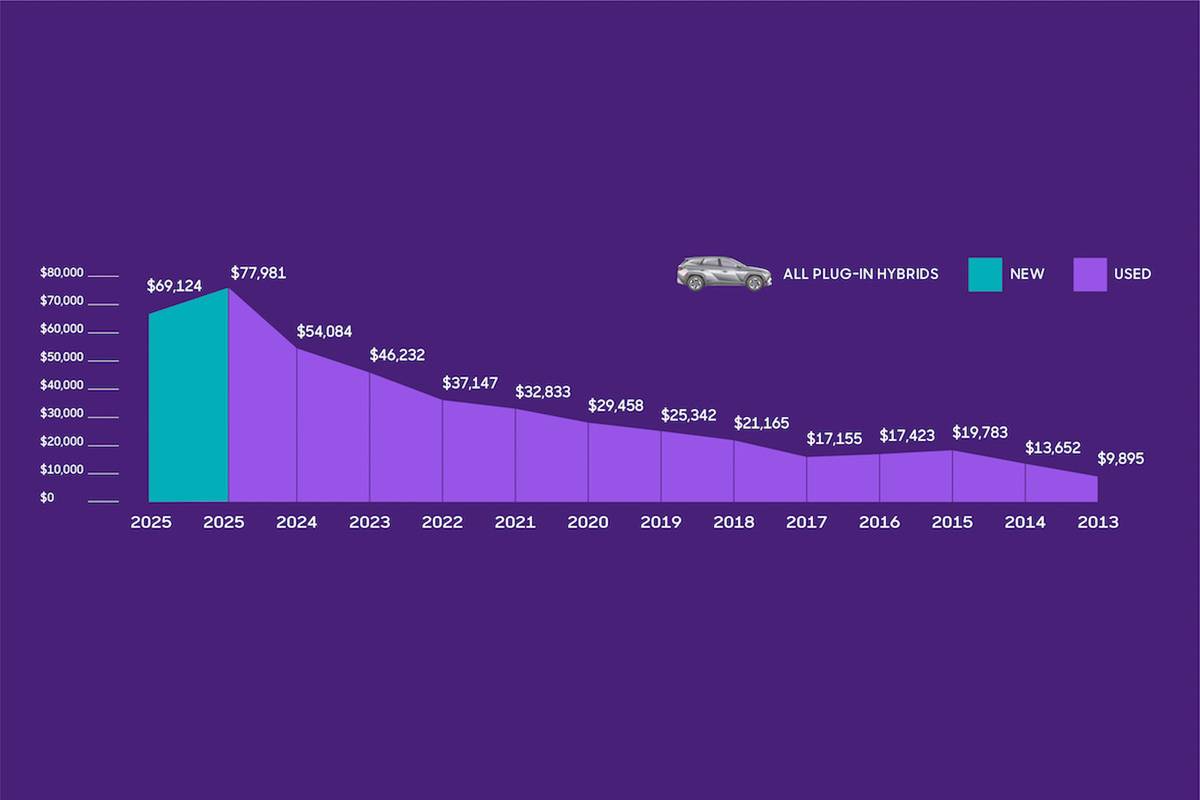
Plug-in hybrids are a great option for commuters who want to daily-drive shorter distances on all-electric power but still want the option of using easier-to-find gasoline on longer trips. Depreciation of PHEVs is closer to that of full-electric vehicles than it is for regular hybrids, though, meaning that they drop in price relatively quickly. The average three-year-old PHEV and EV both sell for roughly half of the average price of a new model. Want to pick up one that’s roughly a quarter of the average new 2025 price? Look at used 2017 models.
Jeep Wrangler 4xe
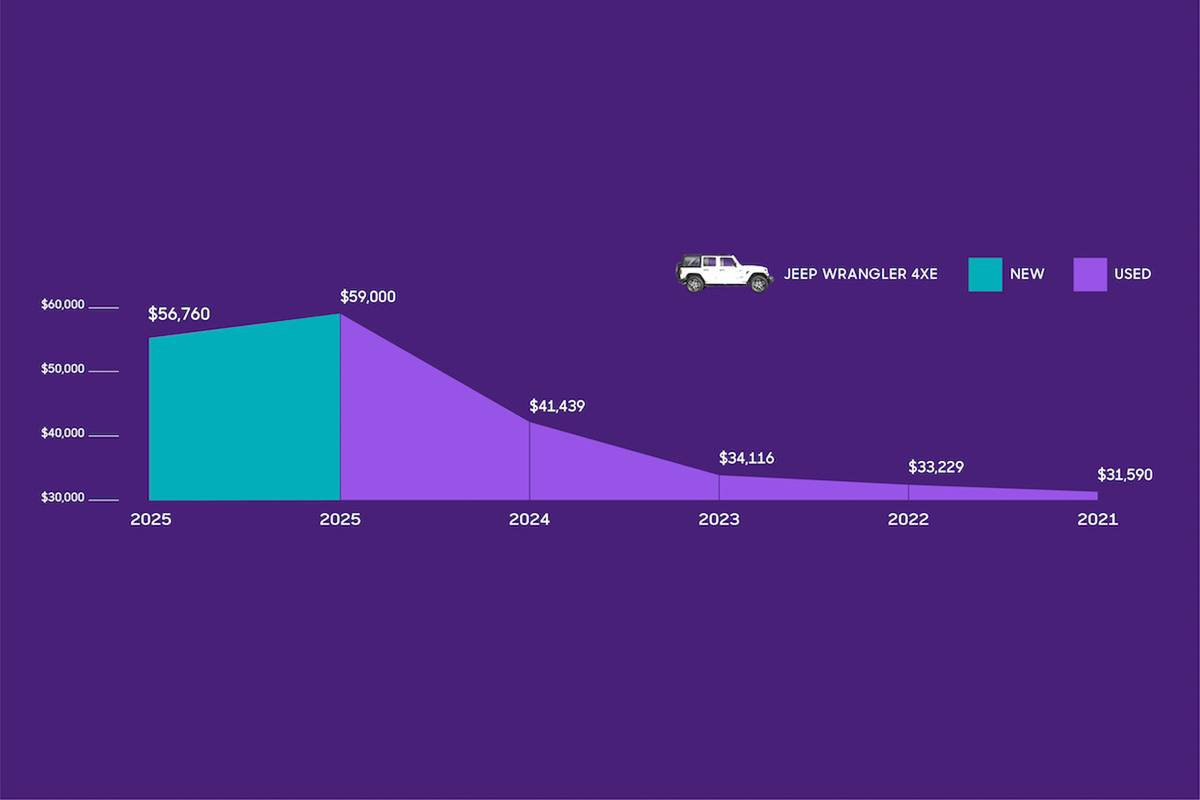
The most popular PHEV on the road is a relatively new one: the Jeep Wrangler 4xe. The combination of an ultra-popular off-roader that can wheel silently on electric power makes it a fun variant of one of the most searched vehicles on Cars.com. The Wrangler 4xe has only been in production since the 2021 model year, and those models sell for an average of 44% less than the new 2025 models. The Wrangler 4xe was refreshed for 2024, and picking up a used 2024 model over a new 2025 one can save you an average of $15,321.
Chrysler Pacifica Hybrid
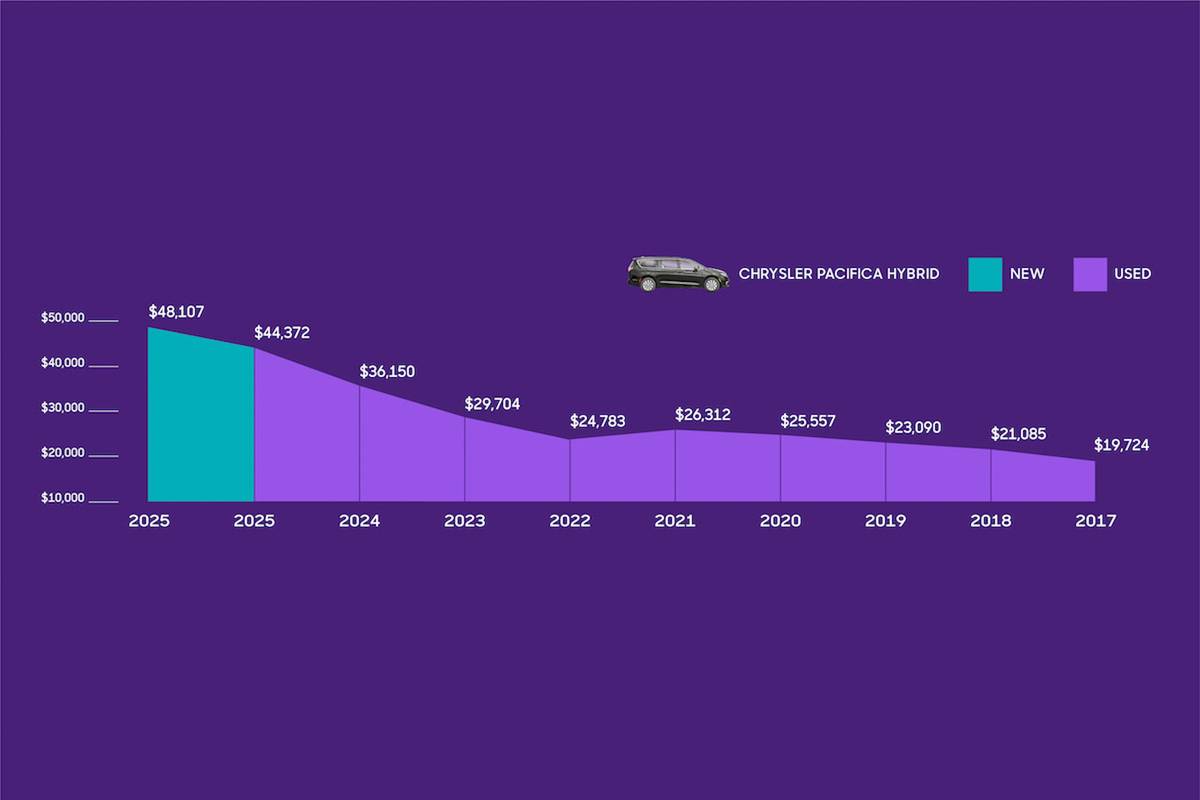
One PHEV that holds more of its value over time is one of the most practical options for bigger families: the Chrysler Pacifica Hybrid. These aren’t the humble Dodge Caravans of yore — the Pacifica Hybrid can be optioned out with luxe finishes and tech options aimed at keeping even the most finicky, boredom-prone kids happy on long trips.
These modern minivans take a big depreciation hit upfront, with the average used 2024 Pacifica Hybrid coming at a 25% discount over a brand-new 2025 van. At three years old, 2022 models sell for nearly half of what new ones do. Depreciation levels off for a bit from there, though, with the average 2017 Pacifica Hybrid selling for 41% of the average new 2025 list price for the model; the average 2017 PHEV has depreciated to just 25% of its new-car list price.
More From Cars.com:
- What Are the Best Used Cars for $15,000?
- Which Tariffs Could Affect Your Next Car?
- What Are the Cheapest Hybrid Cars?
- Which Fuel-Efficient Vehicles Are Most Available?
- What’s the Difference Between a Hybrid and a Plug-In Hybrid?
A Relatively Tariff-Proof Way to Save Cash (for Now)
One upside to buying used in 2025 is that you can’t tariff cars that are already in the United States. While that doesn’t insulate the used-car market completely as rising costs on new cars always push more demand to used cars, looking at used hybrids can give you more options than strictly looking new. As with all of our uncertain-tariff-era guidance, we recommend buying sooner rather than later if you can, as the effects of increased prices for new cars, car parts and fuel tend to snowball into higher costs across the board. That prospect of more price inflation is bad news for anyone taking out an auto loan in particular at a time when interest rates are still elevated in an attempt to get inflation to cool off.
The growing age of the average car on the road also gives away another frugal shopping secret: Cars tend to be more reliable for longer than they were decades ago. Cars that are three years old and newer may have traditionally been the most desirable, but as our look into hybrids’ depreciation shows, you can save a lot more cash and most likely still end up with a reliable car if you expand that search to vehicles that are five years old.
Related Video:
Cars.com’s Editorial department is your source for automotive news and reviews. In line with Cars.com’s long-standing ethics policy, editors and reviewers don’t accept gifts or free trips from automakers. The Editorial department is independent of Cars.com’s advertising, sales and sponsored content departments.

Former News Editor Stef Schrader joined Cars.com in 2024 but began her career in automotive journalism in 2013. She currently has a Porsche 944 and Volkswagen 411 that are racecars and a Mitsubishi Lancer GTS that isn’t a racecar (but sometimes goes on track anyway). Ask her about Fisher-Price Puffalumps.
Featured stories

15-Year Car Loans Aren’t a Thing, But Americans Are Getting More Comfortable With Long Loan Terms

2025 Kia Telluride Review: Rougher Roads Ahead



